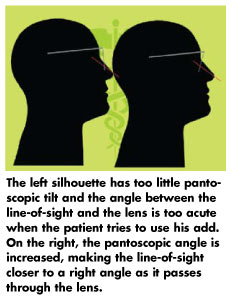
Complaints or Clues
Off-axis errors tend to cause floors and tabletops to appear tilted. Floors that appear to be humped up or scooped out when the patient looks downward at a few feet in front of them is usually caused by lateral prism, either base-in or base-out. Power errors can cause blurring at distance or near, and inappropriate base curves can lead to comments such as “things-are-clear-but-something-isn’t-right.” These kinds of complaints can be important clues that can help you resolve your patient’s difficulties more quickly.
Symptoms, signs, diagnosis and treatment is a classic chain for resolution of problems with eyewear. Patients tend to focus on their symptoms so you will certainly hear about them. Signs, the things you observe such as the fit of the eyewear or pressure marks on the nose or behind the ear, often give important clues. For example, right-handed patients who take their eyewear off with one hand may spread the left temple. The result can yield unequal vertex distances (longer on the right) as well as segs that appear to be too high on the right and too low on the left.
Your diagnosis of a spread left temple will guide you to adjust the left temple inward rather than making the mistake of adjusting the right temple upward to lower the right seg or adjusting the left temple downward to raise the left seg. A soccer ball hit at the juncture of the left temple and the front could cause a similar problem. In this case your re-alignment plan would be the same, but should be followed by suggesting a sturdy pair of sports glasses. Clinical Tip: Always correct unequal vertex distance before realigning the frame if the optical centers (or MRPs) are at unequal heights.
Patients sometimes return having never worn the new eyewear long enough for adaptation to occur. If you hear complaints of the eyewear causing the patient to be taller or shorter, you can be assured that the patient has not worn the lenses for any significant period of time. The taller/shorter phenomenon is an adaptation effect that passes very quickly. The effect is caused by lenses of intermediate or higher power being fitted with the optical centers at different heights relative to the pupils in the new Rx compared to their location in the old Rx. Your job is to decide which height will serve the patient best in the long run. Usually placing the optical centers at about the six o’clock position relative to the pupils works well for most patients. Clinical Tip: Specify MRP heights (or center of pupil heights for PALs) for every lens you order. Otherwise your lab will place the MRPs at the mounting line (i.e. halfway from the top to the bottom of the lens) and this is frequently a root cause for patient difficulties.
Whether your preliminary evaluation reveals a possible cause for your patient’s problem or not, you must evaluate the lenses for a number of potential errors. This should be done systematically and carefully. Never assume that a “quick check” is sufficient because the lenses passed the quality control of your laboratory and the check-out procedure of your own office.
If the lenses are PALs, use the OLA’s lens identifier manual to be sure the manufacturer’s markings are as they should be. Look carefully for areas of distortion, waves and warpage by reflected light as well as by transmitted light. Check lens thicknesses and base curves. The power, thickness and curvature of a lens determine its magnification and patients tend to be sensitive to magnification differences, especially those that interfere with comfortable binocular vision. Your lensometer’s lens clamp and lens table should be used to assure accuracy in power and prism readings.
Blurring at near is common with an increase in plus (either overall or via an add). Generally this is due to over-accommodation and it will pass as the patient “learns” to relax all that accommodative effort. Clinical Tip: Ask patients with increased plus to use extra light for near work for the first few days in the new prescription. This increases the depth-of-field and a normal reading distance can be easily maintained. The increased depth-of-field also optically widens the corridor and the reading area for PAL wearers and it makes adaptation easier, especially if they are first-time PAL wearers.
Although the fit and fabrication of your patient’s eyewear may be right on target, patient difficulties can arise from problems with the design. If you suspect a design problem, it is particularly important to compare the previous eyewear with the new.
Careful Observation Is Important
 Careful observation is the key to unraveling many visual difficulties caused by problems with the fit of the eyewear. Although the patient may be annoyed by the frame sliding down his nose, he will probably not realize that the increase in vertex also increases the plus power of his add resulting in a too short reading distance. The same increase in vertex narrows the usable reading areas of his lenses so that more head movement is required to read a column of print and the lens corridors may no longer be available for binocular viewing making them partially or wholly unusable.
Careful observation is the key to unraveling many visual difficulties caused by problems with the fit of the eyewear. Although the patient may be annoyed by the frame sliding down his nose, he will probably not realize that the increase in vertex also increases the plus power of his add resulting in a too short reading distance. The same increase in vertex narrows the usable reading areas of his lenses so that more head movement is required to read a column of print and the lens corridors may no longer be available for binocular viewing making them partially or wholly unusable.
Looking at the patient from above makes it easy to detect unequal vertex distances. By looking at the patient from the side it is easy to evaluate inappropriate pantoscopic tilt. As you observe from the side, you can hold a fixation target (e.g. your thumb) so that the patient looks straight ahead. If you then lower your thumb slowly so the patient’s lines-of- sight are depressed you can easily tell if the lashes have sufficient clearance and you can also estimate whether the lines-of-sight intersect the lenses at an improper angle (right).
Excessive adaptation problems and difficulties with vision are often caused by errors in fabrication or by the fit of the eyewear. If the problems are just an issue of adaptation, symptoms will lessen with about three days of constant wear for most patients and should resolve within another seven days or so. Patients sometimes can even adapt to minor errors in fabrication, but simply telling the patient the issue is one of adaptation is inappropriate. If your patient feels strongly enough about the issue to return to your office for resolution, you should always give the matter a full measure of your attention.
A Simple Test Identifies Potential Causes
The optical center of the lens represents the point at which light rays pass through undeviated. The optic axis passes through this optical center at right angles to the lens surfaces. Unless prism has been prescribed, the very best lens performance occurs when the patient’s line-of-sight coincides with the optical axis of the lens.
If you want to assure the best lens performance, locate the optic axis rather than simply marking the optical center. To locate the optic axis use a direct ophthalmoscope or penlight at a distance of 20 inches or so from the patient. The patient should be directed to look at the light and you should observe the two reflections of the light (from the front and back lens surfaces). By moving as you keep the light directed toward the patient’s pupil you will find one location at which the two reflections are superimposed to appear as a single reflected point of light. Once located, you need to note the relationship of that reflection to the patient’s pupil and the orientation of your own line-of-sight to the patient’s facial plane.
Most patients do best if the optic axes are straight ahead, parallel and depressed a few degrees downward. If the optic axes are splayed outward the frame may have too much wrap. Note: If the frame is intended to wrap significantly, your lab should be directed to make the appropriate changes in power and MRP location to compensate for the optical changes induced by the wrap.
Optic axes that point more upward in one eye than the other indicate a twist in the bridge that might otherwise be difficult to detect. Unwanted vertical prism also becomes apparent when the optic axis position in one eye is higher or lower than in the other (relative to the patient’s pupils).
Challenges & Opportunities
Patients who return with eyewear problems represent an opportunity to do more than simply resolve problems and complaints. They allow you to develop your skills in eyewear design and they will help you anticipate and avoid future eyewear problems. If you are persistent and meticulous in addressing these challenges, your patients will respect your dedication to their needs and to your profession.
Palmer R. Cook is director of professional education at Diversified Ophthalmics, Cincinnati, Ohio.













